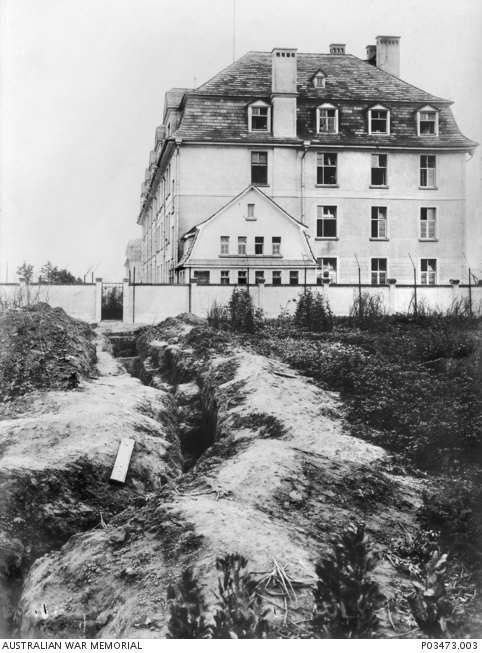Tunnelling to freedom
The escape tunnel leading from the Holzminden prisoner-of-war camp, Germany, November 1918.
Lieutenants Oscar Thomas Flight, Alexander Rintoul and Cecil Molle Feez at the receiving camp at Ripon, North Yorkshire, after repatriation from Germany, c. 1919.
Boldness, resourcefulness and grim determination were the keys to escaping when Australians found themselves prisoners of war. Even then it often was not enough. By Amanda Rebbeck
Lieutenant Cecil Molle Feez was returning to No. 4 Squadron’s aerodrome at Bruay after a strafing raid on the morning of 28 March 1918 when his Sopwith Camel was attacked by a formation of three Albatros scouts from Jasta 52. Feez received a bullet wound to his left thigh and other rounds damaged his fuel tank, causing his motor to lose power. He was forced to land. A German patrol took him away. He was interrogated and then taken to a military hospital where the bullet was removed. He was then transferred to Landshut prisoner-of-war camp in Bavaria.
He had only been promoted to lieutenant earlier in the month, and had joined No. 4 Squadron, Australian Flying Corps (AFC), a month earlier. His war barely begun after he had been inspired by the exploits of a cousin who had made the first British bombing attack over Lessines, Belgium, in 1914, he now found himself a prisoner of war.
Before 1914 hardly any Australians knew what being a prisoner of war meant. In the Boer War only a few dozen Australians had been captured, and they had been quickly released. But during the First World War, more than 4,000 members of the Australian Imperial Force became prisoners in the Middle East and in Europe, and Australians learned firsthand the humiliation, ill-treatment, hunger and sickness of captivity.
At Landshut, a castle where the prisoners were confined in the groom’s quarters of the stables, the men decided they would dig a tunnel out of the prison. They began to dig a hole in the floor of Flight’s room.
Like all prisoners of war, these men began with nothing. Collecting tools and other kit was a long and difficult business. Fortunately for Feez, he, Flight and several other members of their group were chosen to be Red Cross parcel coordinators. Coded messages asking for such things as maps and compasses were sent home in letters and these items were then smuggled into camp in food parcels. Even though the parcels were carefully examined before the prisoners were allowed to have them, much of the contraband got through. What they could not procure from the outside the prisoners had to make for themselves; even tools had to be improvised.
Countless attempts to escape were made during the First World War and each required immense effort. The most successful escape from a German prison camp during the First World War occurred at Holzminden, near Hanover, about 160 kilometres from Holland. The Germans generally regarded Holzminden as “escape proof” – as they did the betterknown Colditz castle in the Second World War – but this was proved wrong when a group of Australian and British officers tunnelled their way to freedom in July 1918. Seventy-five men took part in the escape but the tunnel collapsed after only 29 had got out. Ten eventually reached freedom in Holland.
Attempts were seldom reckless or taken on the spur of the moment. Instead, they were usually carefully planned, and months of thought and work went into their preparation. The smallest detail of disguise or equipment was painstakingly considered; the remotest contingency prepared against as far as possible.
For Feez and Flight the challenge was to dig a 30-metre tunnel using only improvised tools such as cutlery, then trying to dispose of the soil. Feez overcame the soil problem by placing the dirt in the hut’s wall cavities and spreading it around the camp through holes in his pockets via his trouser legs. It was a lot of dirt to move and slow work. It must have been immensely frustrating.
But in a prison camp that otherwise offered little but spirit-crushing boredom, such efforts gave prisoners a purpose, intellectual and creative stimulation and an outlet for selfexpression. Escapes also prevented many men from feeling like they had been left on the shelf, unimportant and unused.
But for every successful escape, many more failed. Schemes that took months of work to prepare were often thwarted at the last moment. In the case of Feez, Flight and their co-conspirators their hard work and preparation were in vain. Their tunnel stretched past the security fence and into an adjoining field of barley when one of the Italian orderlies the men had been bribing reported the tunnel to the Germans. On 8 September 1918 there was a general inspection of the camp, with all prisoners removed to another barrack. Only Flight’s room was searched. The Germans found the tunnel, a compass and maps.
Feez, Flight and another officer were removed from Landshut and placed in isolation for 11 days. For almost a week they received little food and were denied their packages from home. When they were eventually released, they were sent back to Landshut. There Feez and Flight remained until after the signing of the armistice that ended the war.
Cite as: Rebbeck, Amanda, “Tunnelling to freedom”, Wartime 44 (2008) 64–65



